
Norfolk Island Hell in Paradise
Norfolk Island features heavily in the lives of the convicts of the Jillett family. Not only was Elizabeth Bradshaw and Robert Jillett on the island in the First Settlement, many of the family married either convicts or the children of convicts. For the descendants of Thomas Jillett and Mary Ann Shone they have a link to the First Fleeter Edward Westlake and his wife Elizabeth Wood. Their daughter Susannah was Mary Ann Shone's mother.
Nowdays Norfolk Island is a peaceful, relaxing paradise a picture perfect setting. But it has a sinister past, hosting not only one penal settlement, but two.
Just how did the ancestors cope with trying to transform the island into successful agricultural farming? Their conditions were deplorable.
First penal settlement
Norfolk Island is a paradise in the South Pacific ocean, but it had a very different beginning than it now presents to the many tourists who visit each year.
The Convict Barracks
Gravestone of a convict
Example of Convict buildings
Before the First Fleet sailed to found a convict settlement in New South Wales , Governor Arthur Phillips final instructions, received less than three weeks before sailing, included the requirement to colonise Norfolk Island to prevent it falling into the hands of France, whose naval leaders were also showing interest in the Pacific.
Phillip’s instructions given him in April 1787 included an injunction to send a party to secure Norfolk Island “as soon as Circumstances may admit of it…. to prevent its being occupied by the Subjects of any other European Power”. This could only have been a reference to the expedition then in the Pacific commanded by Jean-François de Galaup, . The Daily Universal Register of 11 November 1786 had stated: "the Botany Bay scheme is laid aside, as there is a strong presumption that a squadron from Brest are now, or soon will be, in possession of the very spot we meant to occupy in New Holland". This may have been a reference to a report from the British Ambassador in Paris, who had believed that when La Pérouse’s expedition set out from Brest in August 1785 it had as one of its objectives the establishment of a settlement in New Zealand to forestall the British.
La Pérouse did attempt to visit Norfolk Island, but only to investigate, not to take possession. He had instructions to investigate any colonies the British may have established and learned of the intention to settle Botany Bay and Norfolk Island from despatches sent to him from Paris through St. Petersburg and by land across Siberia to Petropavlovsk in Kamchatka, where he received them on 26 September 1787, just four days before his departure from that port.His ships, the Boussole and Astrolabe, anchored off the northern side of the island on 13 January 1788, but at the time high seas were running that made it too dangerous for the two ships’ boats that were put out to attempt a landing: “It was obvious that I would have had to wait maybe for a very long time for a moment suitable for a landing and a visit to this island was not worth this sacrifice”, he recorded in his journal. Having noted that the island was still uninhabited, he was presumably the less inclined to risk a landing when there was no British settlement there to report on.
When the First Fleet arrived at Port Jackson in January 1788, Phillip ordered Lieutenant Philip Gidley King to lead a party of 15 convicts and seven free men, including surgeon Thomas Jamison (the future Principal Surgeon of New South Wales , to take control of the island and prepare for its commercial development. They arrived on 6 March 1788.
During the first year of the settlement, which was also called "Sydney" like its parent, more convicts and soldiers were sent to the island from New South Wales. A second village was started at Ball Bay, named after the captain of HMS Supply, Lieutenant Henry Lidgbird Ball. On 8 January 1789, the first child was born, Norfolk King, the son of Philip Gidley King and a convict, Ann Inett.[ (Norfolk King went on to become the first British Naval officer born in Australia, and was a Lieutenant, commanding the schooner Ballahoo when an American privateer captured her.)
A “Letter from an Officer of Marines at New South Wales, 16 November 1788”, published in the London newspaper, The World, 15 May 1789, reported the glowing description of the island and its prospects by Philip Gidley King, but also drew attention to the fatal defect of the lack of a safe port: “The said Island lies near Port Jackson, and is nearly as large as the Isle of Wight. Lieutenant King, who was sent with a detachment of marines and some convicts, to settle there, gives the most flattering portrayal of it. The island is fully wooded. Its timber is in the opinion of everyone the most beautiful and finest in the world...they are most suitable for masts, yards, spars and such. The New Zealand flax-plant grows there in abundance. European grains and seeds also thrive wonderfully well on Norfolk Island. It only lacks a good port and suitable landing places, without which the island is of no use, but with them it would be of the greatest importance for Great Britain. How far these deficiencies can be improved by art and the hand of man, time must decide.”
An idealised vision of the new British settlement was given in the novel by Therese Forster, Abentheuer auf einer Reise each Neu-Holland [Adventures on a Voyage to New Holland], published in the German women’s magazine, Flora for 1793 and 1794:
We went towards the centre of this small island where at the foot of a round hill a crystal-clear river rushes forth, dividing up further on into several arms. Towards North and West the hill is covered with the most beautiful ploughed fields all the way down to the sea. The sight of these great flax fields is one of the loveliest I ever beheld. The slender stalks, of the most beautiful green and reaching far above a man’s head, bent in the gentle breeze that blew from the sea. Their red blossoms, shining like rubies, danced in the green waves. The top of the hill and the whole of the south and east sides are covered with enormous pines whose dark green is enhanced by a pleasant foreground of cabbage palms and banana trees, and I also observed a low bush among them the fruit of which resembles our red currants but is much larger and hangs in purple and red clusters that help to give the whole a gay appearance. The dwellings of the colonists are strewn along the fringes of the forest and from my post I could see several of them. Simple houses surrounded by barns and stalls and the fields all enclosed with hedges give the region a youthful appearance the like of which is rarely found in Europe. And plants here bloom more luxuriantly and more perfectly with a natural vigour that knows no exhaustion and fears no poverty, a vigour that has disappeared from our continent.[16]
It was soon found that the flax was difficult to prepare for manufacturing and no one had the necessary skills. An attempt was made to bring two Maori men to teach the skills of dressing and weaving flax, but this failed when it was discovered that weaving was considered women's work and the two men had little knowledge of it. The pine timber was found to be not resilient enough for masts and this industry was also abandoned.
More convicts were sent, and the island was seen as a farm, supplying Sydney with grain and vegetables during its early years of near-starvation. However, crops often failed due to the salty wind , rats , and caterpillars . The lack of a natural safe harbour hindered communication and the transport of supplies and produce.
Manning Clark observed that "at first the convicts behaved well, but as more arrived from Sydney Cove, they renewed their wicked practices". These included an attempted overthrow of King in January 1789 by convicts described by Margaret Hazzard as "incorrigible rogues who took his 'goodwill' for weakness". While some convicts responded well to the opportunities offered to become respectable, most remained "idle and miserable wretches" according to Clark, despite the climate and their isolation from previous haunts of crime.
The impending starvation at Sydney led to a great transplantation of convicts and marines to Norfolk Island in March 1790 on HMS Sirius . This attempt to relieve the pressure on Sydney turned to disaster when Sirius was wrecked and, although there was no loss of life, some stores were destroyed, and the ship's crew was marooned for ten months. This news was met in Sydney with "unspeakable consternation". Norfolk Island was now further cut off from Sydney which, with the arrival of the Second Fleet with its cargo of sick and abused convicts, had more pressing problems with which to contend.
In spite of this the settlement grew slowly as more convicts were sent from Sydney. Many convicts chose to remain as settlers on the expiry of their sentence, and the population grew to over 1000 by 1792.
Lieutenant governors of the first settlement:
·6 March 1788-24 March 1790: Lieutenant Philip Gidley King (1758-1808)
·24 March 1790-Nov 1791: Major Robert Ross (c.1740-1794)
·4 November 1791-Oct 1796: Lieutenant Philip Gidley King
·October 1796-Nov 1799: Captain John Townson (1760-1835)
·November 1799-Jul 1800: Captain Thomas Rowley (c.1748-1806)
·26 June 1800-9 September 1804: Major Joseph Foveaux (1765-1846)
·9 September 1804-January 1810: Lieutenant John Piper (1773-1851)
·January 1810-15 February 1813: Lieutenant Thomas Crane (caretaker)
·15 February 1813-15 February 1814: Superintendent William Hutchinson
Norfolk Island was governed by a succession of short-term commandants for the next 11 years, starting with King's replacement, Robert Ross 1789-1790. When Joseph Foveaux arrived as Lieutenant Governor in 1800, he found the settlement quite run down, little maintenance having been carried out in the previous four years, and he set about building it up, particularly through public works and attempts to improve education.
As early as 1794, King suggested its closure as a penal settlement as it was too remote and difficult for shipping, and too costly to maintain. By 1803, the Secretary of State, Lord Hobart , called for the removal of part of the Norfolk Island military establishment, settlers and convicts to Van Diemen's Land , due to its great expense and the difficulties of communication between Norfolk Island and Sydney. This was achieved more slowly than anticipated, due to reluctance of settlers to uproot themselves from the land they had struggled to tame, and compensation claims for loss of stock. It was also delayed by King's insistence on its value for providing refreshment to the whalers.
The first group of 159 left in February 1805 and comprised mainly convicts and their families and military personnel, only four settlers departing. Between November 1807 and September 1808, five groups of 554 people departed. Only about 200 remained, forming a small settlement until the remnants were removed in 1813. A small party remained to slaughter stock and destroy all buildings so that there would be no inducement for anyone, especially from another European power, to visit that place.
From 15 February 1814 to 6 June 1825 the island lay abandoned.

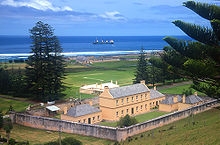
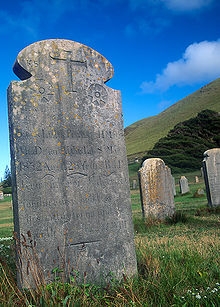
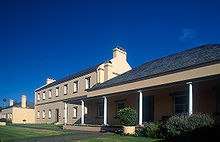
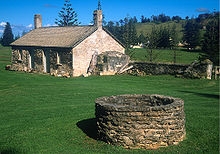
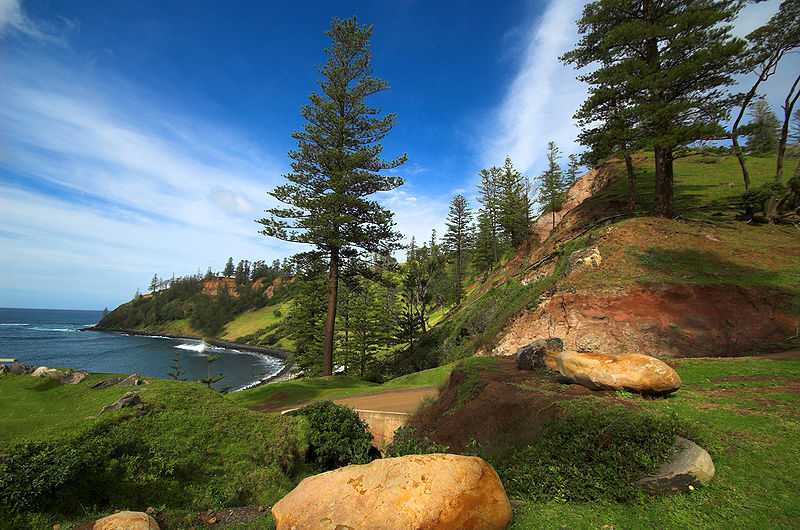
Norfolk Island
Norfolk Island is considered the first established penal colony within the Australian continent. Before the sailing of the first British fleet to establish the continent’s first territory, British Governor Arthur Phillip was specifically instructed to colonize its Eastern Norfolk Island to prevent the land from falling into the hands of the French who were also showing interest in the Pacific. When the fleet arrived at mainland Port Jackson in January of 1788, Phillip ordered Lieutenant Philip Gidley King to lead a party of fifteen convicts and seven free men to establish the island and prepare for its commercial development.
It was soon found that the flax found throughout Norfolk Island was difficult to prepare for manufacturing and required native skills. Two Maori men, indigenous to New Zealand , were brought to the island to teach the colonists how to prepare and later weave the flax. The plan, however, would fail as weaving was the work of native women and the two men had little knowledge of it. The colonists also abandoned Norfolk Island’s potential pine timber industry as the wood was not resilient enough to craft masts.
Regardless, more convicts arrived and the island was used as a farm to supply Sydney with cereal , grain, and vegetables. However the majority of crops did not survive the overseas transportation due to salty winds, rats, and caterpillars. Sydney also lacked a natural safe harbor which proved to hinder communication and the transport of supplies between the island and the mainland.
In March of 1790, with Sydney facing a widespread famine, a great number of convicts and marines were transported to Norfolk Island via HMS Sirius to increase the island’s productivity. The attempt to relieve Sydney’s situation later turned to disaster when the ship was wrecked and most stores were destroyed. The entire crew was marooned for ten months. This news was met in Sydney with great concern as Norfolk Island was now further cut off from the mainland. With the subsequent arrival of England’s Second Fleet carrying a cargo of sick and abused convicts, the city had even more pressing problems to contend with.
As early as 1794, British officials suggested the island’s closure as a penal settlement as it proved too remote and difficult for shipments, and far too costly to maintain. By 1803, the British Secretary of State called for the dismantling of the Norfolk Island military establishment, and exported settlers and convicts to Southern Van Diemen's Land. In February of 1805 the first group, comprised mainly of convicts, their families, and military personnel, departed from Norfolk Island. By 1808, less than 200 settlers remained and formed a small settlement until all societal remnants were removed in 1813 by a small party instructed to slaughter livestock and destroy all buildings leaving little incentive for another European power to colonize the island. The island lay abandoned until 1825.
In 1824, the British government instructed the Governor of New South Wales, Thomas Brisbane, to occupy Norfolk Island as a place to send the worst of convict settlers. Its remoteness, seen previously as a disadvantage, was now viewed as an asset for the detention of men who had committed further crimes since arriving in New South Wales. Governor General George Arthur of Van Diemen's Land believed that prisoners sent to Norfolk Island “should on no account be permitted to return” and the reformation of convicts was dismissed as an objective of the Norfolk Island penal settlement.
In 1846, a report of magistrate Robert Pringle Stuart exposed Norfolk Island’s scarcity and poor quality of food, inadequacy of housing, horrors of torture , and incessant flogging, insubordination of convicts, and corruption of overseers. Bishop Robert Willson later visited Norfolk Island and reported similar findings to the House of Lords, who came to realize the enormity of atrocities perpetrated under the British flag and attempted to remedy the evils. Rumors of resumed atrocities brought Willson back in 1852 and produced a further darning report.
Only a handful of convicts left any written record of such conditions, their descriptions of living and working conditions, food and housing, and, in particular, the punishments given for seemingly trivial offenses are unremittingly horrifying, describing a settlement devoid of all human decency, under the iron rule of the tyrannical autocratic commandants.
The second resurgence of Norfolk Island as a penal settlement began to be wound down by the British Government after 1847, and the last convicts were transported to Tasmania in May 1855.
Van Diemen's Land
Van Diemen's Land was the original name used by the British for the island of Tasmania now part of Australia. The Dutch explorer Abel Tasman was the first European to discover Tasmania. He named the island in honor of Anthony van Diemen, Governor-General of the Dutch East India Company, who had sent Tasman on his voyage of discovery in 1642. In 1803, the island was colonized by the British Empire as a penal colony with the name Van Diemen's Land.
From the 1830s to the abolition of penal transportation in 1853, Van Diemen's Land was the primary penal colony in Australia. Following the suspension of transportation to Norfolk Island, all convicts sent to Australia served their sentences as assigned labor to free settlers, or in chain gangs assigned to public works. Only the most difficult convicts were sent to the Tasman Peninsula prison known as Port Arthur. In total, some 75,000 convicts were transported to Van Diemen's Land, or about 40 percent of all convicts sent to Australia.
Convicts completing their sentences or earning their tickets-of-leave often promptly left Van Diemen's Land to settle in the new free colony of Victoria. Tensions often ran high between the free settlers and the "Vandemonians" as they were termed, particularly during the Victorian Gold Rush when a flood of settlers from Van Diemen's Land rushed to the Victorian gold fields. Complaints from Victorians about recently released convicts from Van Diemen's Land re-offending in Victoria was one of the contributing reasons for the eventual abolition of transportation to Van Diemen's Land in 1853.
In order to remove the unsavory connotations with crime associated with its name, in 1856 Van Diemen's Land was renamed to Tasmania in honor of Abel Tasman. The last penal settlement in Tasmania at Port Arthur finally closed in 1877.
Link to New World Encyclopedia
�
Many stories are to be found on the world wide web about the settlements and the transfer to Van Diemen’s land, and some are included here for reference. A link to the website is provided.
Tasmania - A History of New Norfolk
The following can be found on an Wikipedia internet search.







